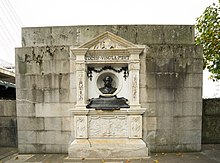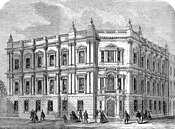| Sir Joseph BazalgetteCB | |
|---|---|
 | |
| Born | Joseph William Bazalgette (1819-03-28)28 March 1819 Clay Hill, Middlesex, England |
| Died | 15 March 1891(1891-03-15) (aged 71) Wimbledon, Surrey, England |
| Occupation | Civil engineer |
| Spouse |
Maria Keogh (m. 1845) |
| Children | 10 |
Sir Joseph William Bazalgette CB (/ˈbæzəldʒɛt/; 28 March 1819 – 15 March 1891) was an English civil engineer. As Chief Engineer of London's Metropolitan Board of Works, his major achievement was the creation of a sewerage system for central London, in response to the Great Stink of 1858, which was instrumental in relieving the city of cholera epidemics, while beginning to clean the River Thames. He later designed Hammersmith Bridge.
Early life
Bazalgette was born at Hill Lodge, Clay Hill, Enfield, the son of Joseph William Bazalgette (1783–1849), a retired Royal Navy captain, and Theresa Philo née Pilton (1796–1850). His grandfather, Louis Bazalgette, a tailor and financier, was a Huguenot immigrant who developed ties to the future George IV and subsequently became wealthy.
In 1827, when Joseph was eight years old, the family moved into a newly built house in Hamilton Terrace, St John's Wood, London. He spent his early career articled to the noted engineer Sir John Macneill, working on railway projects, and amassed sufficient experience (partly in China and Ireland) in land drainage and reclamation to enable him to set up his own London consulting practice in 1842.
In 1845 the house in Hamilton Terrace was sold and Joseph married Maria Keogh, from County Kilkenny in Ireland. At the time he was working so hard on expanding the railway network that two years later, in 1847, he suffered a nervous breakdown.
In 1847, while he was recovering, London's Metropolitan Commission of Sewers ordered that all cesspits should be closed and that house drains should connect to sewers and empty into the Thames. A cholera epidemic ensued, killing 14,137 Londoners in 1849.
Bazalgette was appointed Assistant Surveyor to the Metropolitan Commission in 1849, taking over as Engineer in 1852 after his predecessor died of "harassing fatigues and anxieties." Soon after, another cholera epidemic struck in 1853, killing 10,738. Medical opinion at the time held that cholera was caused by foul air: a so-called miasma. Physician John Snow had earlier advanced a different explanation, which is now known to be correct: cholera was spread by contaminated water, but his view was not then generally accepted.
Championed by fellow engineer Isambard Kingdom Brunel, Bazalgette was promoted Chief Engineer of the Commission's successor, the Metropolitan Board of Works, in 1856 (a post which he retained until the MBW was abolished and replaced by London County Council in 1889). In 1858, the year of the Great Stink, Parliament passed an Enabling Act, despite the colossal expense of the project, and Bazalgette's proposals to revolutionise London's sewerage system began to be implemented. The expectation was that enclosed sewers would eliminate the stink ('miasma') that was thought to be the cause of cholera and, as a result, eliminate cholera epidemics.
Sewer works



At that time, the River Thames was little more than an open sewer, empty of any fish or other wildlife, and an apparent public health hazard to Londoners.
Bazalgette's solution (similar to a proposal made by painter John Martin 25 years earlier) was to construct a network of 82 miles (132 km) of enclosed underground brick main sewers to intercept sewage outflows, and 1,100 miles (1,800 km) of street sewers, to divert the raw sewage which flowed freely through the streets and thoroughfares of London to the river.
The plan included major pumping stations at Deptford (1864) and at Crossness (1865) on the Erith marshes, both on the south side of the Thames and at Abbey Mills (in the River Lea valley, 1868) and on the Chelsea Embankment (close to Grosvenor Bridge; 1875), north of the river. The outflows were diverted downstream, where they were collected in two large sewage outfall systems on the north and south sides of the Thames, called the Northern and Southern Outfall Sewers. The sewage from the Outfall Sewers was originally collected in balancing tanks in Beckton and Crossness, then dumped, untreated, into the Thames at high tide.
The system was opened by Edward, Prince of Wales in 1865, although the whole project was not completed for another ten years.
Partly as a result of the Princess Alice disaster, extensive sewage treatment facilities were built to replace the balancing tanks in Beckton and Crossness in 1900.
The basic premise of this expensive project, that miasma spread cholera infection, was wrong. However, the new sewer system's unintended consequence was removing the causal bacterium from the water supply, thereby eliminating cholera in areas served by the sewers. Instead of the incorrect premise causing the project to fail, the new sewers mostly eliminated cholera, and also decreased the incidence of typhus and typhoid epidemics.
Bazalgette's capacity for hard work was remarkable; every connection to the sewerage system by the various Vestry Councils had to be checked, and Bazalgette did this himself, and the records contain thousands of linen plans with handwritten comments in Indian ink on them "Approved JWB", "I do not like 6" used here and 9" should be used. JWB", and so on. Unsurprisingly, his health suffered as a result. Thames Water holds the records in large blue binders gold-blocked reading "Metropolitan Board of Works" and then dated, usually two per year.
Family

Scion of a Huguenot family, Bazalgette was brought up at 17 Hamilton Terrace, St John's Wood in North West London. In 1845, he moved to Morden, then in 1873 to Arthur Road, Wimbledon, where he died in 1891. He was buried at nearby St Mary's Church, London SW18.
Married in 1845, at Westminster, to Maria Keogh (1819–1902), daughter of Edward Keogh, JP (Ireland), Sir Joseph and Lady Bazalgette had eleven children including:
- Joseph William, born 20 February 1846
- Charles Norman, born 3 March 1847
- Edward, born 28 June 1848
- Theresa Philo, born 11 August 1850
- Caroline, born 17 July 1852; married George Chatterton
- Maria, born 1854; married Robert Wickham
- Henry, born 14 September 1855
- Willoughby, born 18 March 1857
- Maria Louise, born 1859; died unmarried
- Anna Constance, born 3 December 1859, married Major Frederick Blacker
- Evelyn, born 1 April 1861
Awards and memorials


Knighted in 1875, Bazalgette was elected President of the Institution of Civil Engineers in 1883.
A Greater London Council blue plaque commemorates him at 17 Hamilton Terrace in St John's Wood in North London, as well as a formal monument on the Victoria Embankment by the River Thames in central London. In July 2020, the City of London Corporation announced that a new public space west of Blackfriars Bridge, formed following construction of the Thames Tideway Scheme, would be named the Bazalgette Embankment.
Dulwich College has a scholarship in his name either for design and technology or for mathematics and science.

Other works
- Albert Embankment (1869)
- Victoria Embankment (1870)
- Chelsea Embankment (1874)
- Maidstone Bridge (1879)
- Albert Bridge (1884; modifications)
- Putney Bridge (1886)
- Hammersmith Bridge (1887)
- The Woolwich Free Ferry (1889)
- Battersea Bridge (1890)
- Shaftesbury Avenue (1886)
- Early plans for the Blackwall Tunnel (1897)
- Charing Cross Road
- Garrick Street
- Northumberland Avenue
- Proposal for what later became Tower Bridge
Notable descendants
- Will Bazalgette (great-grandson), RCAF pilot awarded the Victoria Cross
- Edward Bazalgette (great-great-grandson), musician and television director
- Sir Peter Bazalgette (great-great-grandson), television producer
Note
- Louis Bazalgette's tailoring account for the Prince Regent (who later became King George IV) was worth over 2 million pounds (adjusted for inflation) and was guaranteed by Parliament.
References
- Halliday, Stephen (2013). The Great Stink of London: Sir Joseph Bazalgette and the Cleansing of the Victorian Metropolis. The History Press. ISBN 978-0752493787.
- Adonis, Andrew; Parris, Matthew (23 September 2014). "Joseph Bazalgette". BBC Sounds. Great Lives. BBC. Retrieved 29 February 2024.
- Ackroyd, Peter (2000). London the biography. London: Chatto & Windus. p. 344. ISBN 9781856197168.
- Farr, William (1868). Report on the Cholera Epidemic of 1866 in England. London: HMSO. p. 146.
- "How the system worked". Crossness Engines. Archived from the original on 2 October 2012.
- CharlotteDunn (30 October 2018). "The Princess Royal visits the Bazalgette Sewer Network". The Royal Family. Retrieved 24 February 2021.
- Mann, Emily (4 April 2016). "Story of cities #14: London's Great Stink heralds a wonder of the industrial world". The Guardian. Retrieved 24 February 2021.
- "'Dirty Old London': A History of the Victorians' Infamous Filth". NPR. 12 March 2015. Archived from the original on 23 June 2017. Retrieved 13 March 2015.
basically took away the possibility of wholesale cholera epidemics in the city, typhus and typhoid – they all were reduced.
- "Obituary – Lady Bazalgette". The Times. No. 36706. London. 4 March 1902. p. 8.
- www.burkespeerage.com
- "Bazalgette, Sir Joseph William (1819–1891)". English Heritage. Archived from the original on 1 August 2011. Retrieved 20 October 2012.
- "Tideway honours Victorian pioneer". The Construction Index. 28 July 2020. Retrieved 28 July 2020.
- The Master's Report to the Governors for the School Year 2004–2005 (PDF) (Report). Dulwich College. p. 7. Archived from the original (PDF) on 17 December 2007.
Further reading
- "Bazalgette, Sir Joseph William" . Encyclopædia Britannica (11th ed.). 1911.
- Sir Joseph William Bazalgette (1819–1891): Engineer to the Metropolitan Board of Works – D P Smith: Transactions of the Newcomen Society, 1986–87 Vol 58.
- London in the Nineteenth Century: A Human Awful Wonder of God – Jerry White, London: Jonathan Cape 2006.
- The Big Necessity: Adventures in the world of human waste by Rose George, Portobello Books, ISBN 978-1-84627-069-7. book review (subscription needed for whole article) in New Scientist
- Beare, Thomas Hudson (1901). "Bazalgette, Joseph William" . In Lee, Sidney (ed.). Dictionary of National Biography (1st supplement). London: Smith, Elder & Co.
- Smith, Denis. "Bazalgette, Sir Joseph William (1819–1891)". Oxford Dictionary of National Biography (online ed.). Oxford University Press. doi:10.1093/ref:odnb/1787. (Subscription or UK public library membership required.)
- Choice or chance? The virtues of London Stock bricks for the construction of the Bazalgette sewer network in London (c.1860-1880)-I J Smalley, A Assadi Langroudi, G.Lill, British Brick Society Information 148, 10–19. 2021.
External links
- "How Bazalgette built London's first super-sewer," by Alwyn Collinson, 26 March 2019, Museum of London
- "Construction of London's Victorian sewers: the vital role of Joseph Bazalgette," by G C Cook, The Fellowship of Postgraduate Medicine
- BBC biography
- Newcomen Society paper (from Internet Archive)
- Battersea Bridge
| Professional and academic associations | ||
|---|---|---|
| Preceded bySir James Brunlees | President of the Institution of Civil Engineers December 1883 – December 1884 |
Succeeded bySir Frederick Bramwell |
- 1819 births
- 1891 deaths
- 19th-century English architects
- Companions of the Order of the Bath
- English civil engineers
- English people of French descent
- Health in London
- Huguenots
- Knights Bachelor
- Metropolitan Board of Works
- People from Enfield, London
- Presidents of the Institution of Civil Engineers
- Presidents of the Smeatonian Society of Civil Engineers
- Thames Water
- Water supply and sanitation in London
